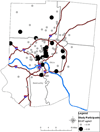Poor asthma control and exposure to traffic pollutants and obesity in older adults
- PMID: 22626595
- PMCID: PMC4715904
- DOI: 10.1016/j.anai.2012.04.009
Poor asthma control and exposure to traffic pollutants and obesity in older adults
Abstract
Background: Environmental and host predictors of asthma control in older asthmatic patients (>65 years old) are poorly understood.
Objective: To examine the effects of residential exposure to traffic exhaust and other environmental and host predictors on asthma control in older adults.
Methods: One hundred four asthmatic patients 65 years of age or older from allergy and pulmonary clinics in greater Cincinnati, Ohio, completed the validated Asthma Control Questionnaire (ACQ), pulmonary function testing, and skin prick testing to 10 common aeroallergens. Patients had a physician's diagnosis of asthma, had significant reversibility in forced expiratory volume in 1 second or a positive methacholine challenge test result, and did not have chronic obstructive pulmonary disease. The mean daily residential exposure to elemental carbon attributable to traffic (ECAT) was estimated using a land-use regression model. Regression models were used to evaluate associations among independent variables, ACQ scores, and the number of asthma exacerbations, defined as acute worsening of asthma symptoms requiring prednisone use, in the past year.
Results: In the adjusted model, mean daily residential exposure to ECAT greater than 0.39 μg/m(3) was significantly associated with poorer asthma control based on ACQ scores (adjusted β = 2.85; 95% confidence interval [CI], 0.58-5.12; P = .02). High ECAT levels were also significantly associated with increased risk of asthma exacerbations (adjusted odds ratio, 3.24; 95% CI, 1.01-10.37; P = .05). A significant association was found between higher body mass index and worse ACQ scores (adjusted β = 1.15; 95% CI, 0.53-1.76; P < .001). Atopic patients (skin prick test positive) had significantly better ACQ scores than nonatopic patients (adjusted β = -0.39; 95% CI, -0.67 to -0.11; P < .01).
Conclusion: Higher mean daily residential exposure to traffic exhaust, obesity, and nonatopic status are associated with poorer asthma control among older asthmatic patients.
Copyright © 2012 American College of Allergy, Asthma & Immunology. Published by Elsevier Inc. All rights reserved.
Conflict of interest statement
Figures

Similar articles
-
Chronic traffic pollution exposure is associated with eosinophilic, but not neutrophilic inflammation in older adult asthmatics.J Asthma. 2013 Nov;50(9):983-9. doi: 10.3109/02770903.2013.832293. Epub 2013 Oct 1. J Asthma. 2013. PMID: 23931679 Free PMC article.
-
Traffic-related pollutants and wheezing in children.J Asthma. 2012 Feb;49(1):5-7. doi: 10.3109/02770903.2011.641049. Epub 2012 Jan 3. J Asthma. 2012. PMID: 22211400
-
Medication use and indicators of poor asthma control in patients with and without allergies.Allergy Asthma Proc. 2019 Jul 3;40(4):221-229. doi: 10.2500/aap.2019.40.4226. Epub 2019 May 3. Allergy Asthma Proc. 2019. PMID: 31053178
-
Recent evidence for adverse effects of residential proximity to traffic sources on asthma.Curr Opin Pulm Med. 2008 Jan;14(1):3-8. doi: 10.1097/MCP.0b013e3282f1987a. Curr Opin Pulm Med. 2008. PMID: 18043269 Review.
-
Obesity and Asthma: Implementing a Treatable Trait Care Model.Clin Exp Allergy. 2024 Nov;54(11):881-894. doi: 10.1111/cea.14520. Epub 2024 Jun 27. Clin Exp Allergy. 2024. PMID: 38938020 Review.
Cited by
-
HEPA filtration improves asthma control in children exposed to traffic-related airborne particles.Indoor Air. 2020 Mar;30(2):235-243. doi: 10.1111/ina.12625. Epub 2019 Dec 8. Indoor Air. 2020. PMID: 31743467 Free PMC article. Clinical Trial.
-
Allergic diseases in the elderly: biological characteristics and main immunological and non-immunological mechanisms.Clin Mol Allergy. 2017 Feb 3;15:2. doi: 10.1186/s12948-017-0059-2. eCollection 2017. Clin Mol Allergy. 2017. PMID: 28174512 Free PMC article. Review.
-
Addition of Montelukast to Low-Dose Inhaled Corticosteroid Leads to Fewer Exacerbations in Older Patients Than Medium-Dose Inhaled Corticosteroid Monotherapy.Allergy Asthma Immunol Res. 2015 Sep;7(5):440-8. doi: 10.4168/aair.2015.7.5.440. Epub 2015 Apr 7. Allergy Asthma Immunol Res. 2015. PMID: 26122504 Free PMC article.
-
Polycyclic aromatic hydrocarbon exposure, obesity and childhood asthma in an urban cohort.Environ Res. 2014 Jan;128:35-41. doi: 10.1016/j.envres.2013.12.002. Epub 2013 Dec 27. Environ Res. 2014. PMID: 24407477 Free PMC article.
-
Effectiveness of a portable air cleaner in removing aerosol particles in homes close to highways.Indoor Air. 2018 Nov;28(6):818-827. doi: 10.1111/ina.12502. Epub 2018 Sep 17. Indoor Air. 2018. PMID: 30133950 Free PMC article.
References
-
- Diaz-Guzman E, Mannino DM. Airway obstructive diseases in older adults: from detection to treatment. J Allergy Clin Immunol. 2010;126:702–709. - PubMed
-
- Stupka E, deShazo R. Asthma in seniors, part 1: evidence for underdiagnosis, undertreatment, and increasing morbidity and mortality. Am J Med. 2009;122:6–11. - PubMed
-
- Gibson PG, McDonald VM, Marks GB. Asthma in older adults. Lancet. 2010;376:803–813. - PubMed
-
- Moorman JE, Rudd RA, Johnson CA, et al. National surveillance for asthma-United States, 1980–2004. MMWR Surveill Summ. 2007;56:1–54. - PubMed
-
- Australian Centre for Asthma Monitoring. Asthma in Australia 2008. Canberra: Australian Centre for Asthma Monitoring, Australian Institute of Health and Welfare; 2008.
Publication types
MeSH terms
Substances
Grants and funding
LinkOut - more resources
Full Text Sources
Medical
Miscellaneous

